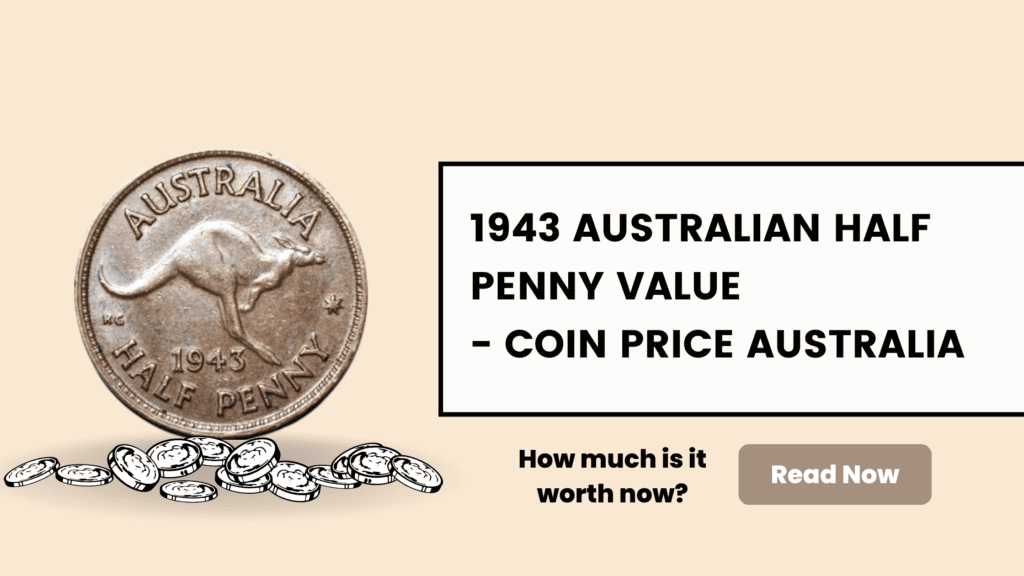Dive into the captivating history and worth of the 1943 Australian penny, a coin that has transcended time to become a sought-after collectible. Discover its significance, the stories it tells, and why it remains a treasure in the world of numismatics.
Unearthing the Legacy: The True Value of the 1943 Australian Penny
The 1943 Australian penny holds a special place in the annals of numismatics and Australian history. As World War II raged on, the coins minted during this period became emblematic of a nation’s resilience and determination.
The 1943 Australian penny value has seen significant appreciation over the years, not just because of its age, but also due to its historical significance. For many collectors and historians, this coin serves as a tangible link to a time when the world was in turmoil, and Australia was making its mark on the global stage.
The Australian penny, as a denomination, has always been a staple of the country’s currency system. Introduced in 1911, the penny was an essential part of everyday transactions, used by Australians from all walks of life. These penny coins were more than just a means of trade; they were a reflection of Australia’s evolving identity, bearing designs and symbols that resonated with the nation’s heritage and aspirations.
Over the years, the designs and materials of the Australian coins have undergone changes, reflecting the socio-political shifts and technological advancements of the times. However, the 1943 penny stands out, not just for its design and material but also for the stories it carries with it – stories of a nation at war, of sacrifice, and of hope.
In this blog post, we will delve deeper into the world of the 1943 Australian penny, exploring its history, significance, and the reasons behind its enduring value. Whether you’re a seasoned numismatist or someone with a budding interest in coins, this journey promises to be both enlightening and captivating.
The Significance of the 1943 Australian Penny
Building on our introduction to the 1943 Australian penny, it’s crucial to delve into the deeper layers of its significance. This coin is not just a piece of metal; it’s a testament to a nation’s spirit during one of the most challenging periods in global history.
The 1943 Australian penny value has grown over the years, not merely due to its age or rarity but because of the stories and memories it encapsulates. While many coins gain value based on their material or scarcity, the 1943 penny’s worth is intrinsically tied to its historical context.
World War II was a defining moment for nations across the globe. Australia, too, played its part in the war effort, with its citizens contributing both on the battlefront and the home front. The penny minted in 1943 became a symbol of this collective effort. Every time it exchanged hands, it served as a subtle reminder of the sacrifices being made and the hope for a brighter future.
The design of the coin further accentuates its significance. The depiction of Georgivs VI, or King George VI, on one side of the penny is not just a nod to Australia’s ties with the British monarchy but also a representation of unity and solidarity. King George’s reign saw some of the most tumultuous times in modern history, and his visage on the coin was a beacon of stability and continuity for many.
In essence, the 1943 Australian penny is more than a collector’s item. It’s a piece of history, a snapshot of a time when the world was in flux, and a nation rallied together, unified in purpose and spirit. As we continue to explore the various facets of this coin, its enduring value and significance become increasingly evident.
Different Mints and Their Marks
As we journey through the history of the 1943 Australian penny, it’s essential to recognize the mints that played pivotal roles in its production. Each mint, with its unique characteristics and marks, contributed to the rich tapestry of Australia’s coinage history.
Perth Mint
Nestled in Western Australia, the Perth Mint has been a cornerstone in the production of Australian coins. Established in 1899, this mint was initially set up to cater to the gold rushes, turning raw gold into sovereigns. However, as the years progressed, its role evolved, and it became instrumental in the production of the Australian penny.
Each coin produced at the Perth Mint carries a distinct mint mark, a testament to its origin and craftsmanship. For the Australian penny, this mark became synonymous with quality and precision, ensuring that every coin that left its premises was a perfect embodiment of Australia’s rich heritage and the mint’s commitment to excellence.
Bombay Mint
While Australia had its mints, the demand and circumstances during World War II led to the outsourcing of some coin production. The Bombay Mint in India, under British rule at the time, stepped in to assist. Pennies produced here were distinct, carrying a unique mint mark that set them apart from their Australian counterparts.
The collaboration with the Bombay Mint was not just about meeting demands; it was a reflection of the global efforts during the war. The pennies from this mint, while adhering to the design and standards of the Australian penny, carried with them a touch of the subcontinent, making them unique collectibles.
Melbourne and Sydney Mints
The Melbourne Mint and Sydney Mint are two of the oldest and most prestigious mints in Australia. Both have played significant roles in shaping the country’s coinage history. While the Sydney Mint, established in 1855, was the first Australian mint, the Melbourne Mint, founded a few years later, quickly became a major player in coin production.
Both mints have their distinct characteristics, with each contributing to the legacy of Australian coins in its own way. Their mint marks, designs, and even the slight variations in coin hues, reflect the regions they represent and their individual histories. Comparing the two is like delving into a tale of friendly rivalry, where both strive for excellence, yet each brings its unique flair to the table.
As we further explore the 1943 Australian penny, understanding the roles and contributions of these mints provides a richer context, painting a vivid picture of a nation’s dedication to preserving its history and identity through its coins.
The Material Composition of the 1943 Penny
Having delved into the mints and their unique marks, it’s equally vital to understand the very fabric of the 1943 Australian penny – its material composition. The choice of metals in coinage is never a mere whim; it’s a reflection of the socio-economic, technological, and at times, political narratives of an era. The 1943 penny’s tale is deeply intertwined with the global backdrop of World War II.
Copper Penny
For centuries, the warm, reddish hue of the copper penny has been a familiar sight in many a hand and pocket. Copper, known for its durability and malleability, has traditionally been the material of choice for many coinage systems, including Australia’s. The copper pennies were not just tools of trade; they were symbols of stability and trust.
The copper planchets, the blank discs upon which the coin’s design was imprinted, ensured uniformity and precision in every penny minted. This meticulous process ensured that each coin was not only of consistent weight and size but also bore the intricate designs with clarity, making them both functional and aesthetically pleasing.
Steel Penny and the War Effort
However, the 1940s brought with them unprecedented challenges. As World War II intensified, copper, a crucial resource for various industries, became increasingly scarce. The war’s demands necessitated a shift in priorities, leading to the birth of the steel penny. Made with a steel core and often coated with zinc, these zinc-coated steel planchets were a departure from the traditional copper pennies.
But these steel pennies were more than just a product of necessity. They were emblematic of a nation’s commitment to the war effort. Every new coin in circulation was a testament to Australia’s adaptability and resilience, a reminder that even in the face of global adversity, the nation could innovate and persevere.
As we continue our exploration of the 1943 Australian penny, it’s evident that its value isn’t just in its rarity or design, but in the stories its very material tells – stories of sacrifice, innovation, and unwavering spirit.
The Value and Rarity of the 1943 Australian Penny
The allure of the 1943 Australian penny lies not just in its historical significance or design but also in its value and rarity. Over the years, this coin has become a sought-after piece for collectors, with its value fluctuating based on various factors.
Estimated and Retail Values
The 1943 Australian penny value has seen a steady appreciation, especially for well-preserved specimens. Based on current market data, the retail value of a 1943 ‘Y.’ Australian penny can range from $0.90 to over $110, depending on its grade and condition. Here’s a breakdown of its value based on grading:
- Very Good (VG): $0.90
- Fine (F): $1
- Very Fine (VF): $5
- Extremely Fine (EF): $25
- About Uncirculated (aUnc): $50
- Uncirculated (Unc): $110+
It’s essential to note that these are retail estimates, and the actual value can vary based on factors like desirability, demand, and the specific circumstances of a sale. The estimated values provide a ballpark figure, but the retail values can offer a more accurate representation of what one might expect when buying or selling such a coin.
Penny Error Coins and Their Worth
In the world of coin collecting, errors can sometimes enhance a coin’s value. The 1943 Australian penny is no exception. While the majority of these pennies were minted with precision, a few penny error coins have been discovered over the years. These errors, whether they be misprints, misalignments, or other anomalies, can make a penny token particularly desirable for collectors.
The value of a penny error coin can vary widely based on the nature and rarity of the error. It’s crucial for collectors and sellers to have the most accurate information when assessing the worth of such coins, as even a minor error can significantly impact its value.
As we continue our exploration of the 1943 Australian penny, it becomes clear that its value is multifaceted, influenced by historical context, material composition, design, and even the occasional minting error.
Source: allcoinvalues.com
Buying and Selling the 1943 Australian Penny
The allure of the 1943 Australian penny has made it a popular item among coin collectors and enthusiasts. As with any collectible, the avenues for buying and selling these coins have expanded, especially with the advent of online platforms. Whether you’re a seasoned collector or someone looking to start their numismatic journey, understanding the nuances of trading this coin is crucial.
Online Marketplaces and Auctions
In today’s digital age, online platforms have become the go-to place for many collectors. Websites like eBay have revolutionized the way coins are bought and sold. With a global reach, sellers can list their 1943 Australian pennies, often accompanied by detailed descriptions, images, and even certificates of authenticity. Buyers, on the other hand, can browse listings from around the world, comparing prices, conditions, and seller ratings.
One of the advantages of platforms like eBay is the added incentives for buyers, such as free shipping. This makes the purchasing process more appealing, especially for international buyers. Additionally, some sellers offer penny tokens or other collectibles as bonuses, further enhancing the buying experience.
Factors to Consider When Trading
While online platforms offer convenience, there are several factors both buyers and sellers should consider when trading the 1943 Australian penny:
- Condition: The value of a coin is heavily influenced by its condition. Coins in excellent condition are likely to fetch higher prices compared to those with wear and tear.
- Authenticity: Given the coin’s value, there are instances of counterfeits in the market. It’s essential to verify the coin’s authenticity, possibly through expert assessments or certificates.
- Mint Origin: The origin of the coin can influence its value. For instance, coins from renowned mints like the United States Mint, United Kingdom, or San Francisco Mint might have different values based on their rarity and demand.
- Documentation: Having proper documentation, such as purchase receipts or authenticity certificates, can enhance a coin’s value and appeal to potential buyers.
In conclusion, while the 1943 Australian penny is a valuable and sought-after coin, it’s essential for both buyers and sellers to approach trading with diligence and knowledge. Being well-informed can ensure a smooth transaction and a worthwhile addition to one’s collection.
Conclusion
The journey of the 1943 Australian penny, from its inception during the tumultuous times of World War II to its current status as a coveted collectible, is nothing short of remarkable. This coin, with its rich history, intricate designs, and the stories it encapsulates, stands as a testament to Australia’s resilience, innovation, and cultural pride. For collectors, it’s not just a piece of metal but a slice of history, a tangible link to a bygone era, and a symbol of a nation’s spirit.
As we reflect on the value of this penny, it’s also worth considering the broader concept of savings and investments. While collecting coins is a form of preserving value, there are more conventional ways to safeguard and grow one’s wealth. For those interested in exploring modern savings avenues, consider checking out the ING Savings High Yield bank account. This account offers a contemporary approach to savings, ensuring your money works for you, yielding additional benefits and returns. Just as the 1943 Australian penny represents a legacy of value, a high-yield savings account symbolizes the future of smart, secure, and fruitful financial planning.
ING Referral Code: $125 Signup Bonus + 5.5% High-Yield Savings Account
Boost your savings with ING high-yield savings account, tailored for...
Open A HYSA TodayFrequently Asked Questions (FAQs) about the 1943 Australian Penny
The 1943 Australian penny's value stems from its historical significance, rarity, and the global context of World War II. Its production during a pivotal time in history, combined with its unique designs and material composition, makes it a sought-after piece for collectors.
While both mints produced the Australian penny, each has its distinct characteristics and mint marks. The Perth Mint is an Australian institution, while the Bombay Mint in India assisted in coin production during World War II due to increased demand. Pennies from the Bombay Mint carry a unique mark, differentiating them from their Australian counterparts.
Authenticity can be verified through specific details in the coin's design, its weight, and the presence of mint marks. Additionally, coins from renowned mints like the United States Mint or the San Francisco Mint may have distinct features. Consulting with a coin expert or obtaining a certificate of authenticity can also help.
Yes, the depiction of King George VI or Georgivs VI on the penny is a nod to Australia's ties with the United Kingdom and the British monarchy. The design represents unity and solidarity during challenging times.
Due to the war effort, copper, a vital resource, was in high demand for various industries. This led to the introduction of pennies made with a steel core and zinc-coated steel planchets as an alternative to the traditional copper pennies.
Yes, there are penny error coins that have been discovered over the years. These errors, whether misprints, misalignments, or other anomalies, can make a coin particularly desirable for collectors and significantly impact its value.
The 1943 Australian penny, Lincoln cent, and steel cents each have their unique histories and significance. While the 1943 Australian penny is valuable due to its historical context and rarity, the Lincoln cent and steel cents from the United States have their own narratives and factors affecting their value. It's essential to evaluate each coin individually based on its history, condition, and market demand.
Researching current retail values, consulting with coin experts, and comparing prices across platforms can help ensure you're making an informed decision. Platforms like eBay often have listings with detailed descriptions, images, and even free shipping offers that can provide additional savings.
Apart from King George VI, artists like Thomas Humphrey Paget and George Kruger Gray made significant contributions to the coin's design, adding depth and character to the penny.
The value of the 1943 Australian penny has seen steady appreciation over the years. Factors like its condition, rarity, historical significance, and market demand have influenced its value. It's always a good idea to stay updated with the most accurate information from trusted sources or experts in the field.




